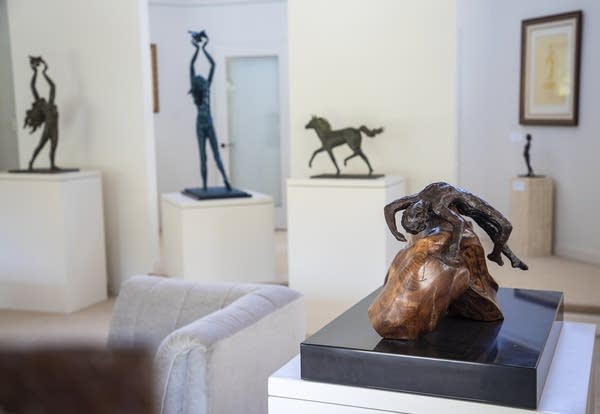Late sculptor's home now a museum of his work

Go Deeper.
Create an account or log in to save stories.
Like this?
Thanks for liking this story! We have added it to a list of your favorite stories.
Tucked away on a residential street in southwest Rochester, you'll find a house like no other in town. Since 2012, Arlyn Gagnon, widow of sculptor Charles Eugene Gagnon, has been transforming her home into a showcase for her late husband's bronze sculptures. She opened the doors to the public last month.
The collection incorporates themes of peace, hope and flight.
Arlyn Gagnon gave me a tour of her home on the 17th anniversary of Sept. 11.
The timing was pure coincidence. But she pointed out it was a fitting day to discuss her late husband's work, which includes the iconic Peace Fountain in downtown Rochester.
Turn Up Your Support
MPR News helps you turn down the noise and build shared understanding. Turn up your support for this public resource and keep trusted journalism accessible to all.
"Chuck and I were working in New York City on 9/11," she said.
They were there while Gagnon worked on his second version of the Peace Fountain, now installed near Cologne, Germany. It's taller than the Rochester version. But both feature a soaring configuration of bronze doves, wingtip to wingtip.

She pointed to a miniature of the fountain on a stand.
"I can remember saying to him, 'If this can survive 9/11 being cast at the art foundry in New York City, it's going to go on to inspire world peace,'" she said.
The tiny replica of the fountain is just one of many pieces in the otherwise unadorned living room.
And that's by design because Charles and Arlyn didn't want the furniture or decorations to distract from the art. When the house was built in the late 1980s, they were already thinking about the future. They wanted a space that could be a gallery as well as a home and studio.
It faces south to maximize light and overlooks an expansive backyard that's slowly being transformed into a sculpture garden. The basement, parts of which open all the way to the second floor, allowed Charles to make large-scale sculptures at home.

But it wasn't until after Charles died in 2012 that Arlyn began plans to make the residence a full-time museum. She said the decision follows the long, but relatively obscure tradition of using sculptors' homes to memorialize their work.
"There aren't many of them, but they are little jewels," she said.
One of her goals is to teach visitors about sculpture making. The education begins the moment you enter the museum. You're greeted by three versions of a woman releasing a dove into the sky, each statue progressively larger.
Arlyn said the sculptures, called "The Spirit of Peace," offer a window into her husband's artistic process — he started small to sketch out the idea, and with each larger version would tweak the design for aesthetic or physical considerations.

"It's like translating language. There's always a change that has to occur," she said.
Unlike most people in Rochester, the Gagnons did not move to the city to be close to the Mayo Clinic. Rather, the two met in Rochester after moving there in the early 1960s — Charles to teach and Arlyn, a painter, for a job at the local art center.
But it was Rochester's understated art scene that convinced the couple to settle there permanently — despite spending extended time in art meccas like New York City and Florence, Italy. When asked why not just live in New York, Arlyn said Charles had a ready answer.
"'If I lived in New York City I'd get together with other artists and sculptors and we would sit around and we would discuss the great works of art we're going to create. In Rochester, I can just create them,'" she recalled.
And create he did.
Charles' work is displayed all over Rochester. A statue of St. Francis sits outside St. Marys Hospital on the Mayo Clinic campus. A bust of hotelier Conrad Hilton is featured in the Mayo building named after him.
Commissions expanded Charles' footprint to Texas, Ohio, Illinois, the U.S. Virgin Islands and Scotland, among other places.
All of his sculptures share the common themes of hope and peace; depictions of hands, birds, uplifted faces and flight give his sculptures movement and weightlessness in spite of the heavy medium.

In the west gallery, there's a piece called "Praying Hands." The gold hands are not tightly clasped. Instead, they're lightly touching and lifted toward the sky.
"Every finger has a different movement," Arlyn said. "When you walk around it, you see something new. Chuck used to say that every sculpture should be like 10,000 paintings."
After leaving the Gagnon museum, I stopped by Peace Plaza in downtown Rochester where Charles' well-known fountain is the centerpiece.

It's one of those clear, dry September days that hints at fall but is still warm enough for people to be out enjoying the sunshine. A couple is playing a lawn game, a man reads on a bench, and kids dip their hands in the running water. Arlyn said it's just the type of peaceful scene Charles had in mind when he designed Peace Fountain.



